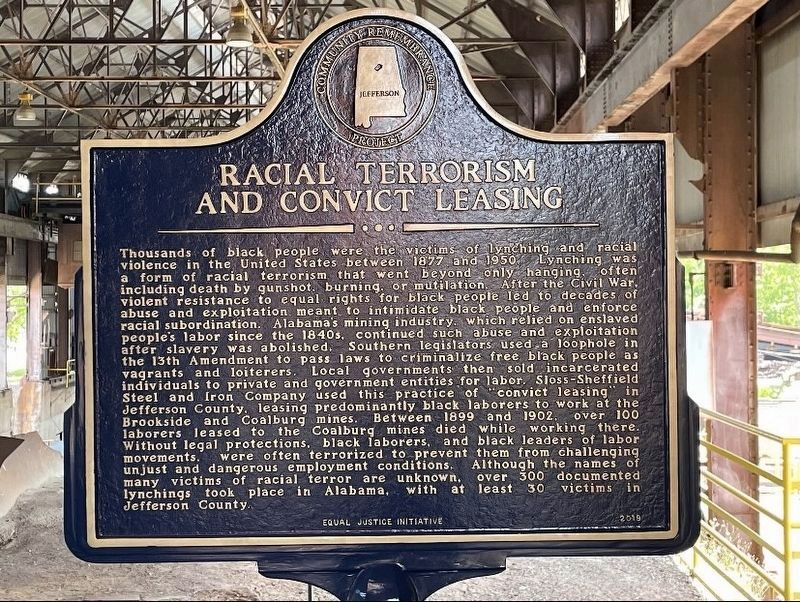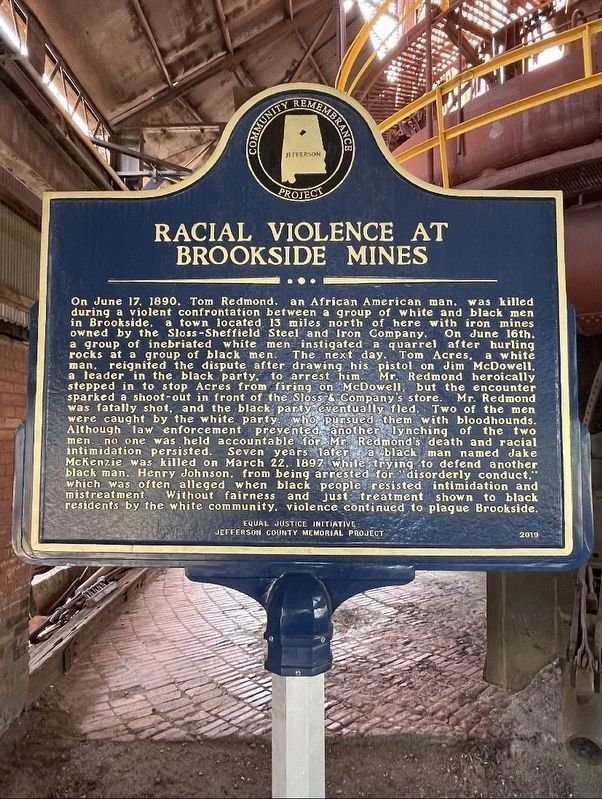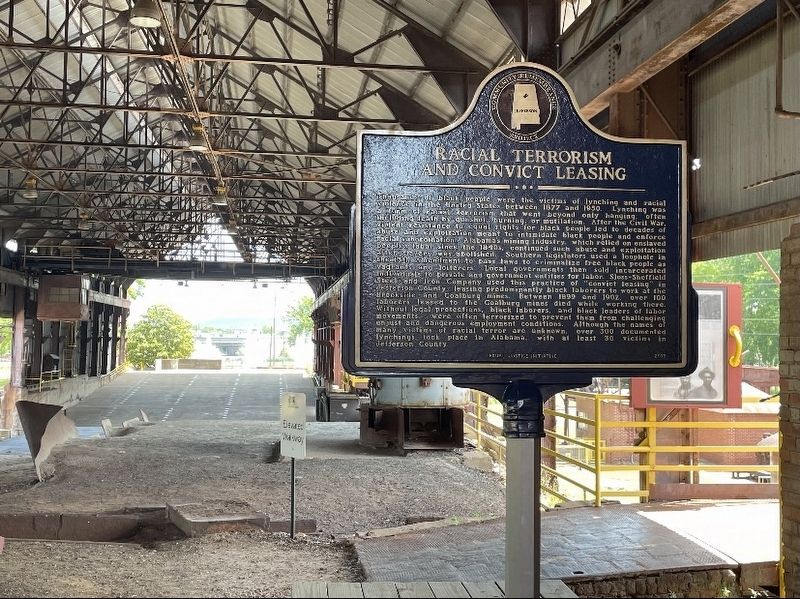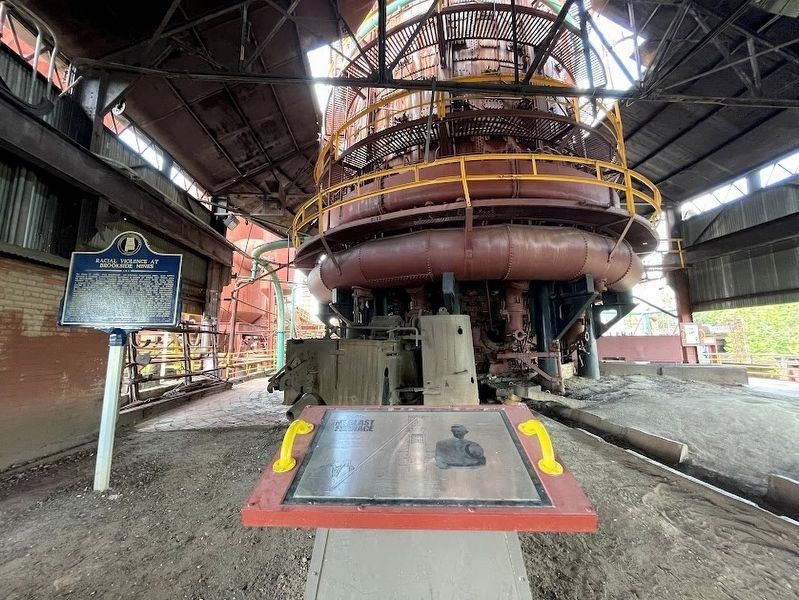Birmingham in Jefferson County, Alabama — The American South (East South Central)
Racial Terrorism and Convict Leasing / Racial Violence at Brookside Mines
Community Remembrance Project
Racial Terrorism and Convict Leasing. Thousands of black people were the victims of lynching and racial violence in the United States between 1877 and 1950 Lynching was a form of racial terrorism that went beyond only hanging, often including death by gunshot, burning, or mutilation. After the Civil War, violent resistance to equal rights for black people led to decades of abuse and exploitation meant to intimidate black people and enforce racial subordination. Alabama's mining industry, which relied on enslaved people's labor since the 1840s, continued such abuse and exploitation after slavery was abolished. Southern legislators used a loophole in the 13th Amendment to pass laws to criminalize free black people as vagrants and loiterers. Local governments then sold incarcerated individuals to private and government entities for labor. Sloss-Sheffield Steel and Iron Company used this practice of “convict leasing” in Jefferson County, leasing predominantly black laborers to work at the Brookside and Coalburg mines. Between 1899 and 1902, over 100 laborers leased to the Coalburg mines died while working there. Without legal protection, black laborers, and black leaders of labor movements, were often terrorized to prevent them from challenging unjust and dangerous employment conditions. Although the names of many victims of racial terror are unknown, over 300 documented lynchings took place in Alabama, with at least 30 victims in Jefferson County.
Racial Violence at Brookside Mines. On June 17, 1890, Tom Redmond, an African American man, was killed during a violent confrontation between a group of white and black men in Brookside, a town located 13 miles north of here with iron mines owned by the Sloss-Sheffield Steel and Iron Company. On June 16th, a group of inebriated white men instigated a quarrel after hurling rocks at a group of black men. The next day, Tom Acres, a white man, reignited the dispute after drawing his pistol on Jim McDowell, a leader in the black party, to arrest him. Mr. Redmond heroically stepped in to stop Acres from firing on McDowell, but the encounter sparked a shoot-out in front of the Sloss & Company's store. Mr. Redmond was fatally shot, and the black party eventually fled. Two of the men were caught by the white party, who pursued them with bloodhounds. Although law enforcement prevented another lynching of the two men, no one was held accountable for Mr. Redmond's death and racial intimidation persisted. Seven years later a black man named Jake McKenzie was killed on March 22, 1897 while trying to defend another black man, Henry Johnson, from being arrested for “disorderly conduct," which was often alleged when black people resisted intimidation and mistreatment. Without fairness and just treatment shown to black residents by the white community, violence continued to plague Brookside.
Erected 2019 by Equal Justice Initiative and Jefferson County Memorial Project.
Topics and series. This historical marker is listed in these topic lists: African Americans • Civil Rights • Industry & Commerce • Law Enforcement. In addition, it is included in the Lynching in America series list.
Location. 33° 31.252′ N, 86° 47.425′ W. Marker is in Birmingham, Alabama, in Jefferson County. Marker can be reached from 32nd Street North. Located within the Sloss Furnaces National Historic Landmark. Touch for map. Marker is at or near this postal address: 20 32nd St N, Birmingham AL 35222, United States of America. Touch for directions.
Other nearby markers. At least 8 other markers are within walking distance of this marker. The Blast Furnace (within shouting distance of this marker); Casting Pigs (within shouting distance of this marker); The Stock Trestle (within shouting distance of this marker); Stock Trestle/Tunnel (within shouting distance of this marker); Slag (within shouting distance of this marker); Sloss Furnaces (within shouting distance of this marker); The Gas System
(within shouting distance of this marker); Sloss Quarters (within shouting distance of this marker). Touch for a list and map of all markers in Birmingham.
More about this marker. A small fee is required for access to the Sloss Furnaces National Historic Landmark. Self-guided and guided tours are available.
Also see . . .
1. Equal Justice Initiative article on marker dedication. (Submitted on May 17, 2021.)
2. History of the Sloss Furnaces. (Submitted on May 17, 2021.)
Credits. This page was last revised on April 20, 2023. It was originally submitted on May 16, 2021, by Darren Jefferson Clay of Duluth, Georgia. This page has been viewed 377 times since then and 34 times this year. Photos: 1, 2, 3. submitted on May 16, 2021, by Darren Jefferson Clay of Duluth, Georgia. 4. submitted on April 18, 2023, by Darren Jefferson Clay of Duluth, Georgia. • Mark Hilton was the editor who published this page.



